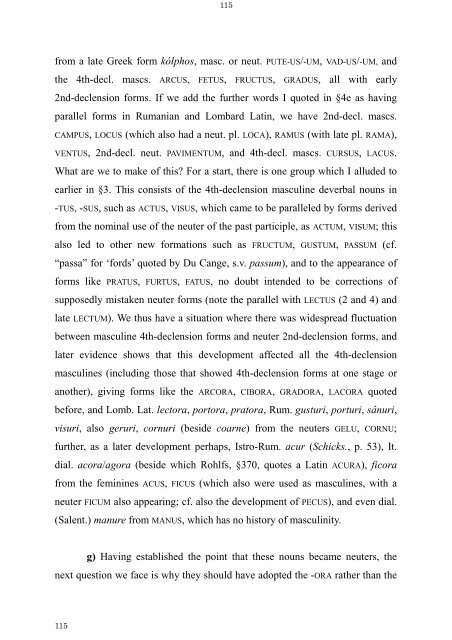The Latin Neuter Plurals in Romance - Page ON
The Latin Neuter Plurals in Romance - Page ON
The Latin Neuter Plurals in Romance - Page ON
You also want an ePaper? Increase the reach of your titles
YUMPU automatically turns print PDFs into web optimized ePapers that Google loves.
115<br />
115<br />
from a late Greek form kólphos, masc. or neut. PUTE-US/-UM, VAD-US/-UM, and<br />
the 4th-decl. mascs. ARCUS, FETUS, FRUCTUS, GRADUS, all with early<br />
2nd-declension forms. If we add the further words I quoted <strong>in</strong> §4e as hav<strong>in</strong>g<br />
parallel forms <strong>in</strong> Rumanian and Lombard <strong>Lat<strong>in</strong></strong>, we have 2nd-decl. mascs.<br />
CAMPUS, LOCUS (which also had a neut. pl. LOCA), RAMUS (with late pl. RAMA),<br />
VENTUS, 2nd-decl. neut. PAVIMENTUM, and 4th-decl. mascs. CURSUS, LACUS.<br />
What are we to make of this? For a start, there is one group which I alluded to<br />
earlier <strong>in</strong> §3. This consists of the 4th-declension mascul<strong>in</strong>e deverbal nouns <strong>in</strong><br />
-TUS, -SUS, such as ACTUS, VISUS, which came to be paralleled by forms derived<br />
from the nom<strong>in</strong>al use of the neuter of the past participle, as ACTUM, VISUM; this<br />
also led to other new formations such as FRUCTUM, GUSTUM, PASSUM (cf.<br />
“passa” for ‘fords’ quoted by Du Cange, s.v. passum), and to the appearance of<br />
forms like PRATUS, FURTUS, FATUS, no doubt <strong>in</strong>tended to be corrections of<br />
supposedly mistaken neuter forms (note the parallel with LECTUS (2 and 4) and<br />
late LECTUM). We thus have a situation where there was widespread fluctuation<br />
between mascul<strong>in</strong>e 4th-declension forms and neuter 2nd-declension forms, and<br />
later evidence shows that this development affected all the 4th-declension<br />
mascul<strong>in</strong>es (<strong>in</strong>clud<strong>in</strong>g those that showed 4th-declension forms at one stage or<br />
another), giv<strong>in</strong>g forms like the ARCORA, CIBORA, GRADORA, LACORA quoted<br />
before, and Lomb. Lat. lectora, portora, pratora, Rum. gusturi, porturi, sânuri,<br />
visuri, also geruri, cornuri (beside coarne) from the neuters GELU, CORNU;<br />
further, as a later development perhaps, Istro-Rum. acur (Schicks., p. 53), It.<br />
dial. acora/agora (beside which Rohlfs, §370, quotes a <strong>Lat<strong>in</strong></strong> ACURA), ficora<br />
from the fem<strong>in</strong><strong>in</strong>es ACUS, FICUS (which also were used as mascul<strong>in</strong>es, with a<br />
neuter FICUM also appear<strong>in</strong>g; cf. also the development of PECUS), and even dial.<br />
(Salent.) manure from MANUS, which has no history of mascul<strong>in</strong>ity.<br />
g) Hav<strong>in</strong>g established the po<strong>in</strong>t that these nouns became neuters, the<br />
next question we face is why they should have adopted the -ORA rather than the









